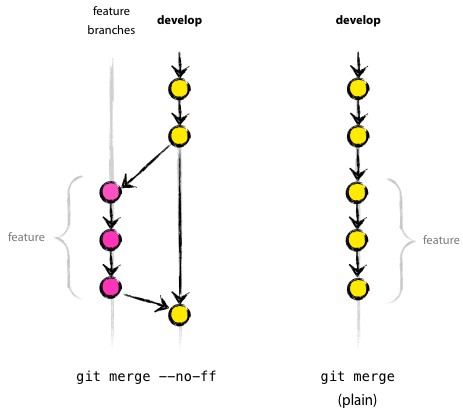Maintainer Notes¶
This is for those with read-write access to upstream. It is recommended to name the upstream remote something to remind you that it is read-write:
git remote add upstream-rw git@github.com:statsmodels/statsmodels.git
git fetch upstream-rw
Git Workflow¶
Grabbing Changes from Others¶
If you need to push changes from others, you can link to their repository by doing:
git remote add contrib-name git://github.com/contrib-name/statsmodels.git
get fetch contrib-name
git branch shiny-new-feature --track contrib-name/shiny-new-feature
git checkout shiny-new-feature
The rest of the below assumes you are on your or someone else’s branch with the changes you want to push upstream.
Rebasing¶
If there are only a few commits, you can rebase to keep a linear history:
git fetch upstream-rw
git rebase upstream-rw/master
Rebasing will not automatically close the pull request however, if there is one, so don’t forget to do this.
Merging¶
If there is a long series of related commits, then you’ll want to merge. You may ask yourself, Merging: To Fast-Forward or Not To Fast-Forward? See below for more on this choice. Once decided you can do:
git fetch upstream-rw
git merge --no-ff upstream-rw/master
Merging will automaticall close the pull request on github.
Check the History¶
This is very important. Again, any and all fixes should be made locally before pushing to the repository:
git log --oneline --graph
This shows the history in a compact way of the current branch. This:
git log -p upstream-rw/master..
shows the log of commits excluding those that can be reached from upstream-rw/master, and including those that can be reached from current HEAD. That is, those changes unique to this branch versus upstream-rw/master. See Pydagogue for more on using dots with log and also for using dots with diff.
Push Your Feature Branch¶
All the changes look good? You can push your feature branch after Merging or Rebasing by:
git push upstream-rw shiny-new-feature:master
Cherry-Picking¶
Say you are interested in some commit in another branch, but want to leave the other ones for now. You can do this with a cherry-pick. Use git log –oneline to find the commit that you want to cherry-pick. Say you want commit dd9ff35 from the shiny-new-feature branch. You want to apply this commit to master. You simply do:
git checkout master
git cherry-pick dd9ff35
And that’s all. This commit is now applied as a new commit in master.
Merging: To Fast-Forward or Not To Fast-Forward¶
By default, git merge is a fast-forward merge. What does this mean, and when do you want to avoid this?

(source nvie.com, post “A successful Git branching model”)
The fast-forward merge does not create a merge commit. This means that the existence of the feature branch is lost in the history. The fast-forward is the default for Git basically because branches are cheap and, therefore, usually short-lived. If on the other hand, you have a long-lived feature branch or are following an iterative workflow on the feature branch (i.e. merge into master, then go back to feature branch and add more commits), then it makes sense to include only the merge in the main branch, rather than all the intermediate commits of the feature branch, so you should use:
git merge --no-ff
Handling Pull Requests¶
You can apply a pull request through fetch and merge. In your local copy of the main repo:
git checkout master
git remote add contrib-name git://github.com/contrib-name/statsmodels.git
git fetch contrib-name
git merge contrib-name/shiny-new-feature
Check that the merge applies cleanly and the history looks good. Edit the merge message. Add a short explanation of what the branch did along with a ‘Closes gh-XXX.’ string. This will auto-close the pull request and link the ticket and closing commit. To automatically close the issue, you can use any of:
gh-XXX
GH-XXX
#XXX
in the commit message. Any and all problems need to be taken care of locally before doing:
git push origin master
Releasing¶
Fix the version number. Open setup.py and set:
ISRELEASED = True
Clean the working tree with:
git clean -xdf
But you might want to do a dry-run first:
git clean -xdfn
Tag the release. For a release candidate, for example:
git tag -a v0.3.0rc1 -m "Version 0.3.0 Release Candidate 1" 7b2fb29
If on a new minor release (major.minor.micro format) start a new maintenance branch, for example:
git checkout -b maintenance/0.3.x
Any bug fixes and maintenance commits intended for the next micro release should be made against master as usual, but tagged with the milestone for the micro release it is intended for. Then merge into master as usual. When ready to do the backports, use the file
tools/backport_pr.pyto identify which PRs need to be backported and to apply them to the maintenance branch. The tag for the release should be made in the maintenance branch.Upload the source distribution to PyPI:
python setup.py sdist --formats=gztar,zip register upload
Go back to setup.py and set isreleased = False and bump the major version in master.
Update the version numbers in the statsmodels/statsmodels-website repo. These are in conf.py. Also upload the released version docs to stable/, move stable/ to a placeholder for older version documentation.
Make an announcment
Profit
Commit Comments¶
Prefix commit messages in the master branch of the main shared repository with the following:
ENH: Feature implementation
BUG: Bug fix
STY: Coding style changes (indenting, braces, code cleanup)
DOC: Sphinx documentation, docstring, or comment changes
CMP: Compiled code issues, regenerating C code with Cython, etc.
REL: Release related commit
TST: Change to a test, adding a test. Only used if not directly related to a bug.
REF: Refactoring changes
